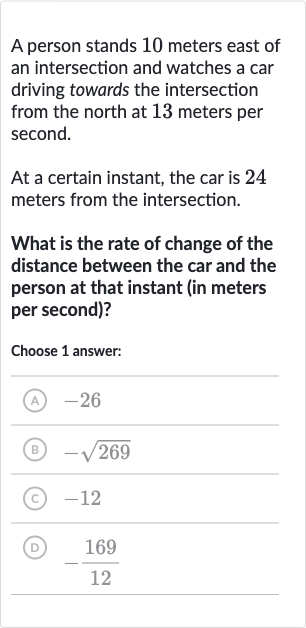AI tutor
Welcome to Bytelearn!
Let’s check out your problem:

A person stands meters east of an intersection and watches a car driving towards the intersection from the north at meters per second.At a certain instant, the car is meters from the intersection.What is the rate of change of the distance between the car and the person at that instant (in meters per second)?Choose answer:(A) (B) (C) (D)
Full solution
Q. A person stands meters east of an intersection and watches a car driving towards the intersection from the north at meters per second.At a certain instant, the car is meters from the intersection.What is the rate of change of the distance between the car and the person at that instant (in meters per second)?Choose answer:(A) (B) (C) (D)
- Draw Triangle: First, let's draw a right triangle where the car's distance from the intersection is one leg ( meters), and the person's distance from the intersection is the other leg ( meters). We're looking for the rate of change of the hypotenuse, which represents the distance between the car and the person.
- Calculate Initial Distance: Using the Pythagorean theorem, we calculate the initial distance between the car and the person.
- Find Rate of Change: Now, we need to find the rate of change of this distance. Since the car is moving towards the intersection, the distance between the car and the person is decreasing. We'll use related rates to find this rate of change.
- Use Related Rates: Let's denote the distance between the car and the intersection as , the distance between the person and the intersection as (which is constant at meters), and the distance between the car and the person as .
- Simplify Equation: The Pythagorean theorem in terms of , , and is: Differentiating both sides with respect to time , we get:
- Apply Values: Since is constant, is , and we can simplify the equation to:
- Calculate Rate of Change: We know that (the speed of the car) is meters per second (negative because is decreasing), and we want to find (the rate of change of the distance between the car and the person).
- Calculate Rate of Change: We know that (the speed of the car) is meters per second (negative because is decreasing), and we want to find (the rate of change of the distance between the car and the person).Plugging in the values we have: meters per second
More problems from Rate of travel: word problems
QuestionGet tutor help
QuestionGet tutor help
QuestionGet tutor help
QuestionGet tutor help
QuestionGet tutor help
QuestionGet tutor help
QuestionGet tutor help
QuestionGet tutor help
